EXCLUSIVE ARTICLE |
||
|
||
EXCLUSIVE ARTICLE |
||
|
||
 |
|
With international filmmakers coming up with ever more bizarre concepts to make money from a James Bond spoof, perhaps the strangest of all was the Italian production O.K. Connery (re-titled Operation Kid Brother for international release). As had been the case with Casino Royale, the producers first approached Sean Connery to appear in their film, and not unsurprisingly the actor emphatically refused. At this stage in his career, and in spite of his difficult relationship with EON producers Harry Saltzman & Albert R. Broccoli, there was no way Connery was going to play a James Bond-like role, the character he was doing his utmost to escape from. So, enterprising Italian producer Dario Sabatello got the next best thing, his brother. |
|||
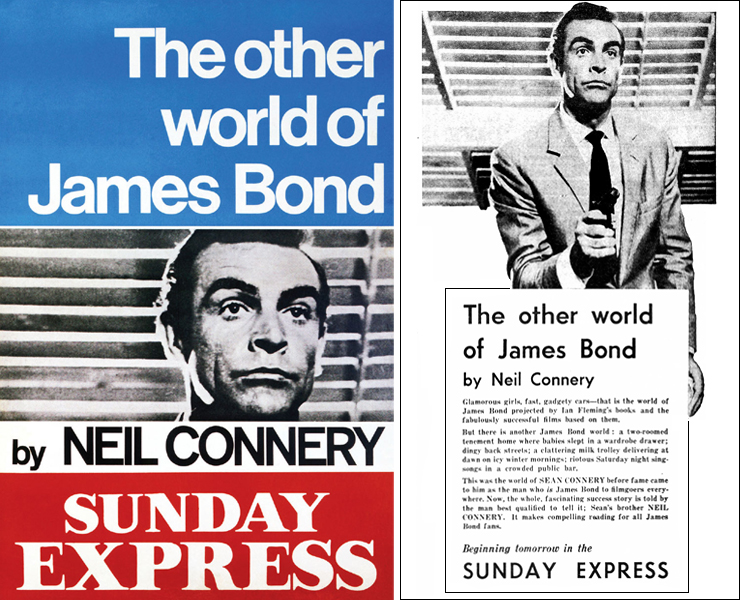 |
|||
|
Sean and Neil Connery
had always been very close whilst growing up in Edinburgh, and
remained supportive of each other throughout their lives, but nothing
angered the elder sibling more than the production that became known
internationally as Operation Kid Brother in 1967.
Neil Connery
(1938-2021) had no previous acting experience, and had been working as
a plasterer in Scotland, but dismissed from a recent job after losing
his tools. The story garnered much media attention based on the
connection with his more famous brother. Neil Connery had also sold
the story of his early years growing up with his elder brother that would be
serialized in the Sunday Express in August of 1965. |
|||
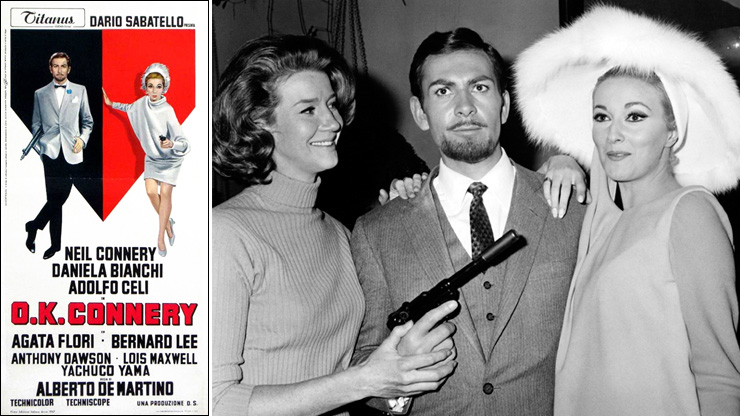 |
|||
|
Sean Connery tried to get the film stopped and told producer Dario Sabatello “By getting my brother to make this kind of picture you are exploiting us both”. Undeterred Neil and director Alberto De Martino (1929-2015) started filming on November 13, 1966 in the Mediterranean, and the backstory of the production was picked up by the Daily Mirror, with a full page news item on December 29, 1966. The report concluded with Sabatello's assertion that Neil could take over as James Bond when his brother abdicated. You Only Live Twice co-producer Harry Saltzman said of Sean Connery: “He is not very happy about his brother doing this picture. It would appear to be an attempt by the Italian to make a fast dollar”, and added “But one thing is certain. Neil Connery will never take over from his brother as James Bond.” Neil Connery appeared rather embarrassed by the whole affair: “You may think I'm trying to cash in on my brother's scene,” he said, “but I can tell you he's sick to death of playing James Bond.” In another story in the Liverpool Echo on February 10, 1967, Neil claimed: “People have said that Sean doesn't like what I'm doing, but that's not true. He wished me luck, and gave me two pieces of advice: ‘Make sure things are in black & white before you sign them... and that they're to your advantage.’” Neil Connery was reportedly paid £5,000 to appear in the film, which was a far cry from his £3 a day as a plasterer. Sean Connery would also refuse to appear in a photograph with his brother to publicise Operation Kid Brother. Whatever truth surrounded the various newspaper stories, the brothers remained close in private life, with Neil attending both the Scottish Gala Premiere of Diamonds Are Forever (1971) at the ODEON Clerk Street, Edinburgh (below left) on January 14, 1972; and the UK Charity Premiere of Never Say Never Again (below centre) at the Warner West End cinema on December 14, 1983. Neil was also at his brother's side as he was knighted by Her Majesty Queen Elizabeth II at an investiture ceremony held at Holyrood Palace in Edinburgh on July 5, 2000. |
|||
 |
|||
 |
|||
|
In addition to starring the brother of the current James Bond, the Italian-made spoof co-starred several actors who had already played in the EON Productions series opposite Sean Connery; including Bernard Lee, Lois Maxwell, Daniela Bianchi, Anthony Dawson and Adolfo Celi. O.K. Connery was released in Italy in April 1967, and then picked up for international distribution by United Artists as one of six Italian productions they released that year, including the three Sergio Leone ‘Dollar’ Westerns starring Clint Eastwood. Neil Connery never got to use his own voice in any version of the film. He was re-voiced in the original Italian release, and when it came to do the dubbing for the US version he was undergoing treatment for appendicitis, and subsequently re-voiced with an American accent. Although the name ‘James Bond’ is never mentioned in the film, there were none-too-subtle asides indicating that the character of Dr. Neil Connery was in fact the brother of the famous secret agent. |
|||
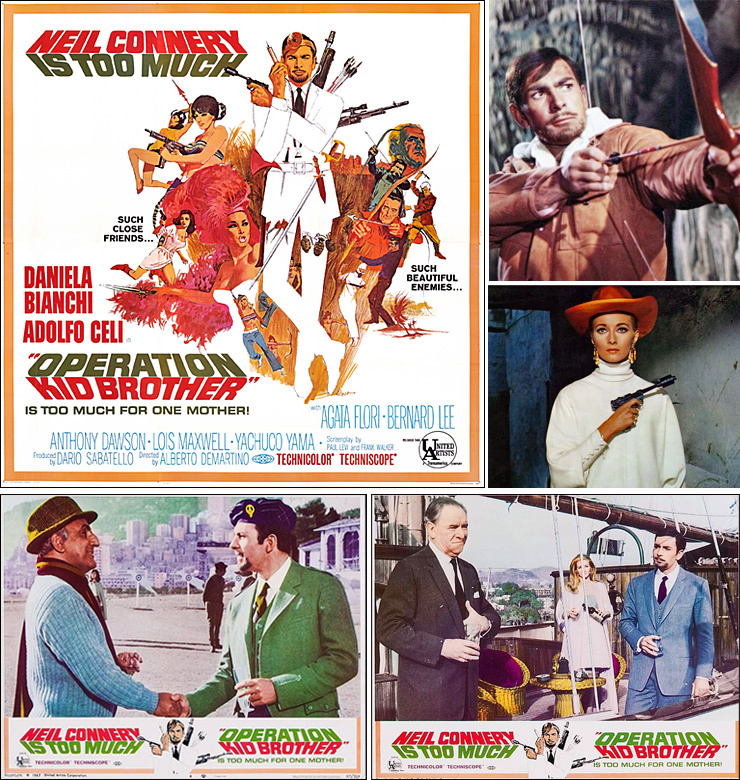 |
|||
|
For the US release in November 1967 the film was re-titled Operation Kid Brother, and despite some less than positive reviews did make money for United Artists. In addition to its cast of James Bond alumni Operation Kid Brother boasted a score by legendary Italian composer Ennio Morricone (1928-2020), and an eye-catching Robert McGinnis style film poster by renowned American illustrator Ron Lesser. Neil Connery would make one more big screen appearance in The Body Stealers (1969), a British low-budget science fiction film starring George Sanders and Patrick Allen. Following a handful of supporting roles in British TV series in the early 1980s, Neil Connery's third and final film was Aces Go Places 3 (1984) as ‘Mr. Bond’. The Hong Kong made action-comedy was also released in an English-language version titled Mad Mission 3: Our Man from Bond Street (the final instalment of the Aces Go Places series). Yet another James Bond/spy spoof, the film also featured an appearance by Richard Kiel, who played Jaws in The Spy Who Loved Me (1977) and Moonraker (1979). |
|||
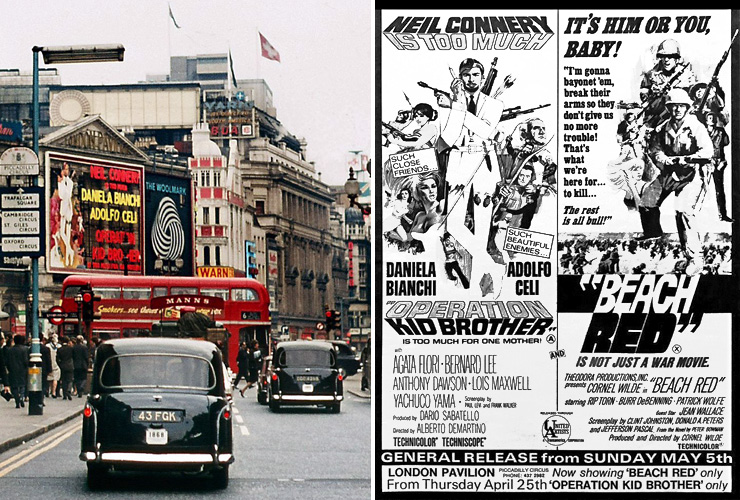 |
|||
|
Operation Kid Brother also played at United Artists’ flagship cinema the London Pavilion for three weeks from Thursday April 25, 1968, before going on general release across the UK on a double-bill with Beach Red (1967) starring Cornel Wilde, who also produced and directed the anti-war film set in the Pacific during WWII. The general release pairing with an ‘X’ certificate main feature no doubt hampered the box-office receipts in the UK by restricting the audience to those over 16 years of age. Operation Kid Brother did play briefly as a standalone release in the early 1970s under its ‘A’ certificate, and then as a late-night attraction in several provincial cinemas. The controversial ‘X’ certificate Beach Red had played the four weeks preceding Operation Kid Brother at the London Pavilion. English critics were no kinder to the film that their American counterparts. A review in the Kensington Post on May 3, 1968 under the title “Bond 'n blood” began:
|
|||
 |
|||
|
With Goldfinger not seen on UK cinema screens for just over two years, it became the perfect film to be paired with the most successful James Bond film to date Thunderball, in what would be the second official 007 double-bill released by United Artists. Goldfinger was originally revived at the London Pavilion, Piccadilly Circus for two weeks commencing Thursday June 20, 1968 (just five weeks after Sean Connery's brother Neil had vacated the venue with Operation Kid Brother). This was immediately followed by Thunderball which played for another 13 days, finishing on July 16th to make way for the World Premiere of The Beatles Yellow Submarine. Along with Thunderball, the double-bill of Dr. No/From Russia With Love had proved to be one of the biggest money-spinners for distributor United Artists in 1965/66. United Artists came up with a clever marketing plan to cash in on the school summer holidays and generate more interest for the new Thunderbird 6 film, by releasing it with the two most successful James Bond films. Thunderbird 6 had unusually already has its world premiere engagement at the 300-seat Jaceyland cinema within Baker Street Underground station on Thursday June 26, 1968, where it played for five weeks before a wider release with the two James Bond films. Although completed in late 1967, United Artists were unsure when to release the second Supermarionation film given the relatively poor box-office performance of its predecessor Thunderbirds Are Go, which had premiered at the London Pavilion on December 12, 1966. With United Artists’ flagship venue playing the two James Bond revivals in June/July 1968 this was presumably why UA selected the small Jaceyland cinema as the venue for the premiere engagement of Thunderbird 6 in London. The cinema (the only one situated within a London Underground station) had originally opened in 1938 showing newsreels, and was a popular venue for the screening of children's films, cartoons, and later cult classics. |
|||
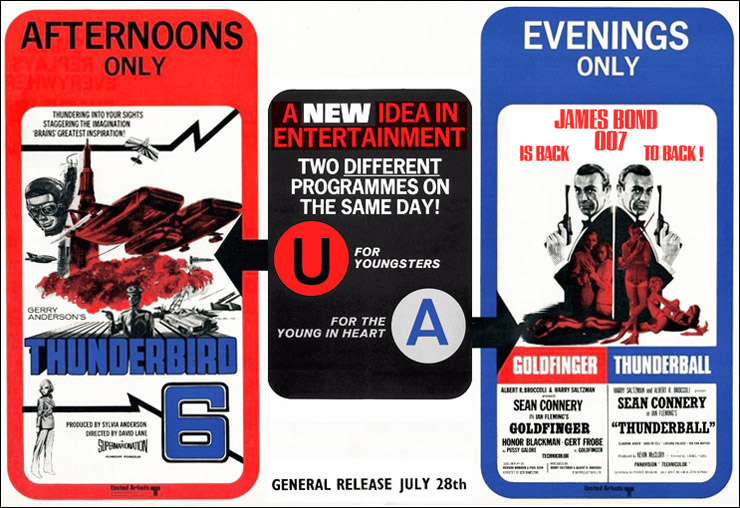 |
|||
|
The National Screen Service produced an Exhibitors’ Campaign Book showcasing the usual promotional gimmicks and marketing material available to cinemas and newspapers. This was primarily focussed on the two Bond films, but composite material was produced to promote all three films at cinemas which booked the new programme. Cinema managers were reminded that Goldfinger/Thunderball was a special release; and in many locations the films would be screened in the evenings only, with Thunderbird 6 shown as an afternoon programme accompanied by Pink Panther cartoons. Releasing two different programmes as separate performances on the same day was a new idea in entertainment, and it was therefore important at theatres where this scheme was in operation, that the general public were not confused. The three films played first in Scottish cinemas for six days from Monday July 15, 1968. Traditionally Scottish school summer holidays start earlier than in England, so naturally cinema managers wanted to take advantage of their captive audience as soon as possible. Sunday July 28, 1968 saw the general release in England, with the programme playing in North London cinemas on the Rank circuit for one week; with South London cinemas playing the films from Sunday August 4, 1968. |
|||
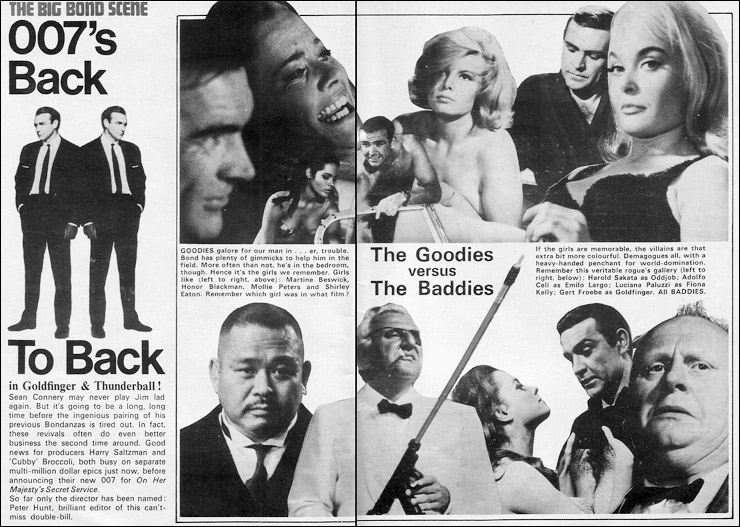 |
|||
|
The combination of Thunderbird 6 and Goldfinger/Thunderball was a very short-lived experiment, lasting only six weeks during the summer of 1968. The July issue of the free magazine Showguide [pictured above] which was available in ODEON cinemas, reminded audiences that ‘'...Sean Connery may never play Jim lad again. But it's going to be a long, long time before the ingenious pairing of his previous Bondanzas is tired out. In fact these revivals do even better business the second time around...’. The double-page feature also informed readers that the search was on for a new 007 for On Her Majesty's Secret Service, but so far only the director Peter Hunt had been named, and also crediting him as the brilliant editor of the can't miss double-bill. On October 7, 1968 George Lazenby was announced as the new James Bond at a reception at the Dorchester Hotel in London, and filming of the sixth 007 film began in Switzerland later that month. |
|||
|
|||
|
|||
|
Since its release in December 1969, On Her Majesty's Secret Service was then the only James Bond film seen in UK cinemas for 18 months. Following George Lazenby's departure, Harry Saltzman & Albert R. Broccoli then began searching once again for a new actor to play James Bond, and in January 1971 announced that American John Gavin would take the role in Diamonds Are Forever. Distributor United Artists were still not convinced, and in a last-ditch attempt managed to lure back Sean Connery for one more film with a record-breaking $1-million pay check. John Gavin was paid off and the return of Sean Connery announced on March 2, 1971. With Connery back as Bond, United Artists now had the chance to re-release his earlier embargoed 007 adventures in cinemas ahead of the premiere of Diamonds Are Forever at the end of 1971. However, it would be an unlikely pairing with three other United Artists distributed films that were also coming to the end of their cinematic lives. The hastily produced posters had the tag-line “The One and Only...”, as if to erase George Lazenby from the public's memory forever. Although On Her Majesty's Secret Service was very popular when released provincially across the UK in 1970, many cinemas were still struggling as attendance declined to an all-time low of 193-million admissions that year, compared to 500-million a decade earlier. On Her Majesty's Secret Service had a very brief revival in the Summer of 1971, but was then largely unseen for the next three years until it was re-released on a double-bill with Live And Let Die. |
|||
 |
|||
|
|
|||